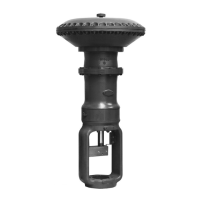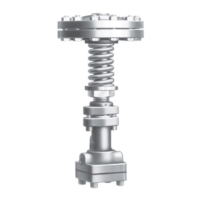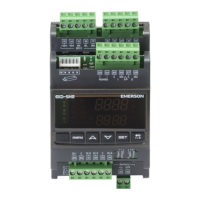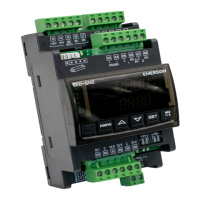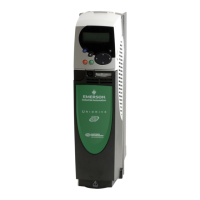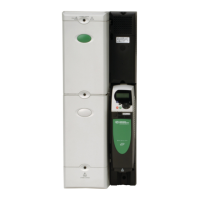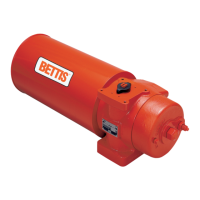Digital Sensor Control Software Overview • 5-5
5.2.3 Alarm Output When On/Off
Parameters
Alarm When On redefines the definition of “active” as
it refers to the state of the Alarm output. When the Sensor
Control application calls for the Alarm output to be ON
the Alarm output will change to the state specified in the
Alarm When On field. Select either ON, OFF, or NotAct
in this field. Alarm When Off redefines the definition of
“inactive” as it refers to the state of the Alarm output.
When the Sensor Control application calls for the Alarm
output to be OFF, the Alarm output will change to the state
specified in the Alarm When Off field. Select either OFF,
ON, or NotAct in this field.
5.2.4 Control Bypass
The digital output may be bypassed with a timed
bypass. The output may be bypassed to ON, OFF or
NONE. Once the STRT TIMED BYP goes high, the
bypass remains in effect until the Bypass Time has
expired. The CNCL TIMED BYP will cancel any bypass
and operation will return to normal. If STRT TIMED BYP
is still on, it must go low for one update before it will acti-
vate another bypass.
5.3 Digital Sensor Control
The Digital Sensor Control read the values from one or
more digital sensors, combine them using a series of
logical commands, and operate a digital output (such as a
relay) based on the result of the logical combination.
The Digital Sensor Control module performs three
basic functions:
• LOGICAL COMBINATION - up to four inputs
may be combined using standard logical
combination methods (such as AND, OR, XOR).
The result is the command output value, which can
be used to operate a relay.
• BYPASS - The command output may be
configured to be bypassed to a fixed value by a
switch or button press.
• ALARMING - Alarms and notices can be
generated based on the command value of all the
digital inputs of the cell, plus occupancy, and
schedules.
5.3.1 Control Strategy
The Digital Output Module cell provides a mechanism
for combining multiple Digital Outputs into a single
output that can be used as an input to other cells.
The inputs can be combined as the following:
• AND - logical AND of inputs
• OR - logical OR of inputs
• XOR - logical XOR of inputs
• VOTE - result will be ON if the number of inputs
ON > number of inputs OFF
• FIRST - returns the logical value of the first good
(non-DV_NONE) input. There is also a First Good
output which shows the number 1-4 of the first
good input.
The Digital Output Module allows for a user to specify
two different input combination strategies: a primary
combination type, and an alternate combination type. The
module reads the state of the Use Alternate Combination
method input to determine which combination method to
use.
The combined value is then sent to a Schedule
Interface strategy. The Schedule Interface strategy allows
the user to modify the combined value based upon the
occupied or unoccupied state of the system. Two different
combination strategies may be specified by the user; a
primary combination strategy and an alternate
combination strategy. When the Use Alt Shed input is
LOW, the primary combination is used. When the Use Alt
Shed input is HIGH, the alternate combination strategy is
used.
The output is then sent to a Min On/Min Off property
that sets its output based on the Min On/Min Off delay
times.
The resulting output is passed to a One-Shot
calculation for applications that require a pulse rather than
a logic level. The output of the One-Shot can be a pulse of
length Pulse Width seconds that starts when the input to
the One-Shot rises or falls depending on the Timer Type
selection.
The Proof Fail output will be active as a result of
comparing the final control value with the Proof input. If
the input and output do not match for a length of time
equal to the Proof Delay, the Proof Fail output will go to
ON. It will stay ON for at least Proof Latch Dur seconds.
The user can select to use the actual value from the
Command output or the output from the Min On/Min Off
property. The proof will generate an alarm if the Proof
Alarm Type property is not set to Disabled.
There is also a counter on the Command Out that
provides a running count that increments every time the
Command Out cycles to ON and a digital Counter Trip
Output that is ON when the Counter value is greater than
the Counter's trip point. The user enters the initial value
and the count increments by the Count Inc value. The
Count output value is reset by sending a signal to the Reset
Count input. The Count Reset Type parameter specifies
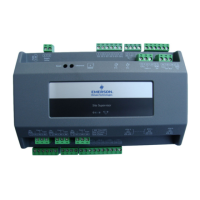
